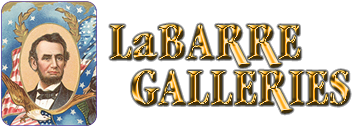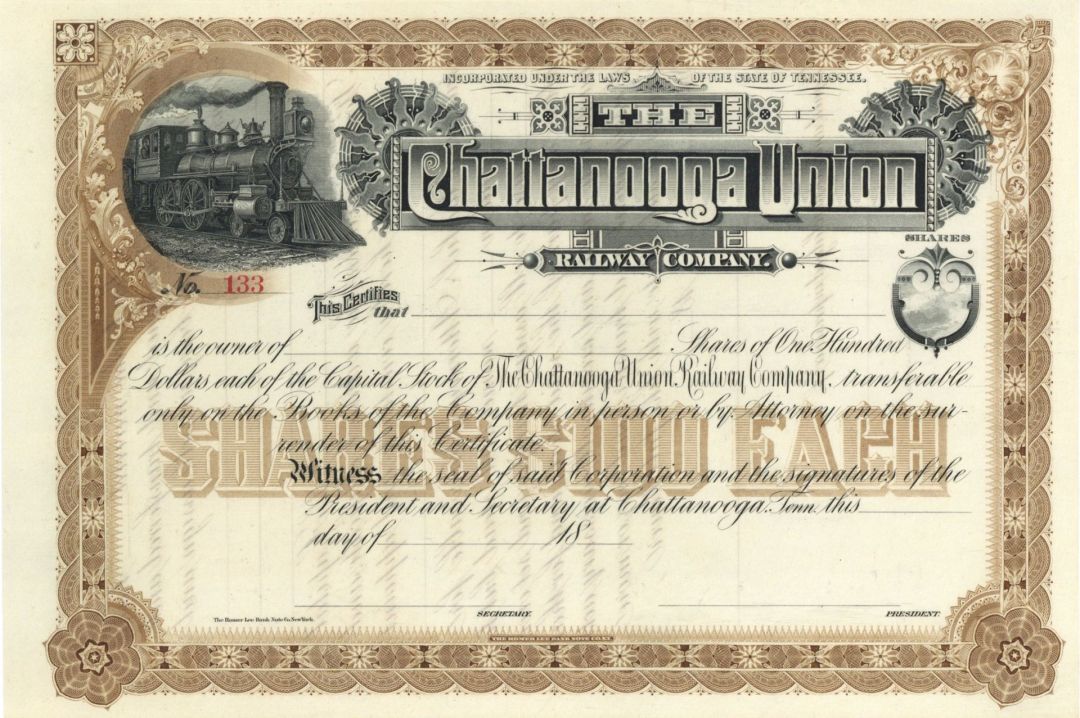Chattanooga Union Railway Co. - circa 1880's Unissued Railroad Stock Certificate
Inv# RS2623A StockUnissued Stock. Scarce Popular State! The line was incorporated in Tennessee in the 1880’s operating from 1888 to 1895. This company organized into the Belt Railway of Chattanooga in 1895. The Belt Railway operated about 45 miles of track in and around Chattanooga, Tennessee.
The Chattanooga Union Station holds significant historical value in the context of railroading in Tennessee. It served as the terminal for the first railroad, the Western and Atlantic, to enter the state and was the first union station constructed through the collaboration of multiple railroads. During the Civil War, it was strategically vital, with troops from both the Confederate and Union armies frequently passing through. In Miller's Photographic History of the Civil War, Volume 7, pages 35 and 37, there are images of captured Confederate soldiers awaiting transport in front of the Chattanooga Union Station on their way to Northern prisons.
Numerous prominent political and military figures traversed the station during the Civil War and continued to do so until more efficient means of travel became available. For nearly seventy years, the Union Station housed the renowned Confederate locomotive, the General, which played a pivotal role in the famous locomotive chase during the Civil War. Ownership disputes over the General have occurred, and it is currently situated in Georgia.
Furthermore, the Union Station is of paramount importance to Chattanooga as it is the oldest surviving structure in the city, likely the only one that predates the Civil War. Various highway projects and other initiatives have largely erased traces of Chattanooga's early history, underscoring the Union Station's immense significance to the region.
The Union Station in Chattanooga, which exemplifies typical railroad stations of the mid-19th century in small junction towns like Chattanooga, lacks significant architectural distinction. It remains uncertain whether an architect was involved in its design, although some attribute it to civil engineer E.A. Vineent. Vineent also designed the Atlanta Union Station, the southern terminus of the Western and Atlantic Railroad in Georgia, which was destroyed by Sherman in 1864. The original Union Station in Chattanooga was a utilitarian train shed constructed in 1858, characterized by a large, overhanging concave roof supported by brick masonry arches, covering six tracks and featuring waiting rooms, a baggage room, and a ticket office at the northern end.
An elaborate system of wooden trusses upheld the roof. Currently, about one-third of the original structure remains, as the rest was demolished in 1926-27 when railroad management opted for more practical modern 'butterfly-sheds.' In 1881, an addition was made to the train shed, which still stands today. This two-story Victorian-style brick building extended from the train shed to the sidewalk on Ninth Street and was adorned with white stone trim. According to contemporary newspaper reports, it housed the usual passenger waiting rooms, an emigrant's room, a restaurant, a lunch counter, a baggage room, and ticket offices. By the 1970s, the station had a neglected appearance, serving only one passenger train in each direction daily and attracting a mere handful of travelers, a stark contrast to the bustling activity of fifty years prior, when the sounds of porters, trainmen, and the powerful coal-fired engines echoed from the expansive concave shed above.
Shortly after the aforementioned addition was completed, a new freight depot was constructed on Ninth Street, adjacent to Union Station. The design of this depot closely mirrored that of Union Station itself. This freight depot was ultimately demolished in 1969, followed by the rest of the station in 1973.
A stock certificate is issued by businesses, usually companies. A stock is part of the permanent finance of a business. Normally, they are never repaid, and the investor can recover his/her money only by selling to another investor. Most stocks, or also called shares, earn dividends, at the business's discretion, depending on how well it has traded. A stockholder or shareholder is a part-owner of the business that issued the stock certificates.











Ebay ID: labarre_galleries